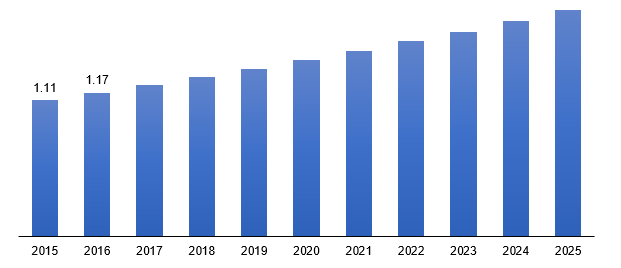
China Coolant (antifreeze) Market Size And Forecast, By Technology (OAT (Organic Acid Technology), HOAT (Hybrid Organic Acid Technology), IAT (Inorganic Acid Technology)), And Segment Forecast, 2015 - 2025
- Published: February, 2019
- Format: Electronic (PDF)
- Number of pages: 30
- Industry: Bulk Chemicals
Industry Insights
The China coolant (antifreeze) market was valued at USD 1.24 billion in 2017 and is expected to grow at a CAGR of 5.2% from 2017 to 2025. The antifreeze demand in the automotive sector of China is expected to witness significant growth over the forecast period owing to the increasing production of passenger cars and commercial vehicles on a domestic level.
China coolant market size and forecast, 2015 - 2025 (USD Billion)

Antifreeze has high thermal capacity, low viscosity, non-toxic nature, and chemical inertness and helps in reducing excessive heat. Antifreeze is also used as corrosion protection chemical in automotive, aerospace, marine and industrial sectors. Additionally, some applications require the coolant to be an electrical insulator.
While the rising vehicle production in the country is one of the key drivers, China is a fast-moving market for electric vehicles which is expected to hinder antifreeze demand in the coming years. Also, the volatile price of raw materials, primarily ethylene and propylene, which are derived from petrochemicals such as ethane and propane, tends to affect the market at large.
Segmentation by Technology
• OAT (Organic Acid Technology)
• HOAT (Hybrid Organic Acid Technology)
• IAT (Inorganic Acid Technology
Based on technology, the market is classified into organic, inorganic, and hybrid organic acid technology (OAT) coolant. OAT coolant exhibits anti-corrosive properties and is based on fully neutralized azoles and organic acids. These coolants are based on the chemistry of amine, silicate, nitrite, and borate and are used in light-duty and heavy-duty diesel machines.
Hybrid organic acid technology coolants (HOAT) are hybrid coolants containing components from OAT ethylene glycol and traditional ethylene glycol containing nitrites, while inorganic acid technology (IAT) contains either ethylene glycol or propylene glycol.
In 2017, organic acid technology (OAT) accounted for the major share of the market. High demand for coolants based on minimally depleting carboxylate technology as substitutes for conventional antifreeze based on silicates, nitrates, phosphates, and amines is expected to translate into demand over the forecast period.
Conventionally, antifreeze agents were based on inorganic acid technology (IAT) that offer high protection to automobile engines against liner pitting, boil overs, and cavitation. However, these products have lost favor to OAT coolants in recent years on account of their high cost and maintenance needs.
It is mainly used in industrial heating & cooling systems and automotive and aerospace industry. In the automotive industry, coolants are used in passenger cars, light commercial vehicles, heavy commercial vehicles, and motorcycles. They are used in the engine coolant system, radiators, and windshield fluid systems. Furthermore, these product forms are used as heat transfer fluids in heating, ventilation & air conditioning systems (HVAC) and industrial heating & cooling systems.
Coolant is an integral part of an automotive as it protects the engine against corrosion and freezing. These products play a critical role in heat dissipation and maintaining the overall engine heat balance. Growing automotive production mainly in China is expected to propel its demand in the automotive sector.
The Chinese automobile industry is the largest in the world in terms of produced vehicle volume and the country has witnessed increased production over the past few years. The growing per capita income of the country has positively affected the demand for automobiles as well in the domestic market. The country’s growing automotive sector has gained the interest of some of the leading global brands. For instance, BMW has signed an agreement with Brilliance Automotive Group Holdings, BMW’s Chinese partner, to increase the number of vehicles produced in China.
In 2018, the National Development and Reform Commission (NDRC) announced draft rules to regulate investment in the automotive industry. The draft advocated limiting additional capacity for gasoline-powered cars, but at the same time promotes the growth of electric vehicles. Foreign investments in R&D in key technologies, manufacturing of engines, electric motors, and batteries for new energy vehicles are encouraged.
Competitive Landscape
The China antifreeze market is highly fragmented with the presence of a large number of players. Antifreeze consumed in China is majorly produced by domestic manufacturers. Foreign manufacturers also produce it in the country on account of easy availability of raw material.
The majority of players are investing in R&D in order to develop products which are less toxic and more environmentally friendly. Some of the players operating in the market are BASF SE, Arteco, Cummins Filtration, Bluestar (Beijing) Chemical Machinery Co.Ltd, and CCI Corporation.

Choose License Type
- World's largest premium report database
- Transparent pre & post sale customer engagement model
- Unparalleled flexibility in terms of rendering services
- Safe & secure web experience
- 24*5 Research support service
